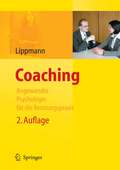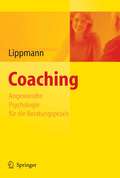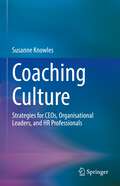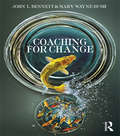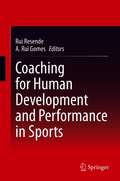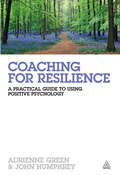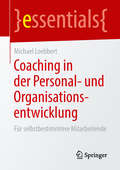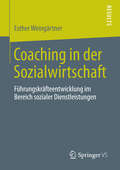- Table View
- List View
Coaching - Angewandte Psychologie für die Beratungspraxis
by Eric LippmannCoaching ist in aller Munde, der Markt mittlerweile unübersichtlich. Um trotzdem den Überblick zu behalten, werden in dem Band Coaching-Ansätze systematisch vorgestellt: das Wichtigste in Kürze, typische Fragestellungen, Fallbeispiele, Erfolgskriterien, Besonderheiten der Zielgruppen. Mit Informationen zu wichtigen Settings im Coaching-Prozess und Tipps für unterschiedliche Anwendungsfelder. Ein Serviceteil hilft bei der Auswahl von Coaches und bietet Links zu Aus- und Weiterbildung, Kongressen, Zeitschriften sowie kommentierte Literaturtipps.
Coaching - Angewandte Psychologie für die Beratungspraxis
by Eric LippmannOb einzeln, in der Gruppe, kollegial, extern oder intern, als Selbst- oder Online-Coaching: Die Settings für den Coaching-Prozess sind zahlreich. Ob Coaching für Führungskräfte im unteren, mittleren oder im Top-Management, im Familienunternehmen, für Schulleiter (und auch: für Lehrer), im Personalmanagement oder in der Politik: Auf die jeweilige Zielgruppe abgestimmtes Coaching ist sinnvoll. Ob Coaching bei Veränderungsprozessen, bei Konflikten, im Rahmen der betrieblichen Bildung, im Umgang mit Medien, bei Laufbahnfragen, bei Freistellungen: Coaching ist bei den unterschiedlichsten Anwendungsfeldern und Fragestellungen möglich. Die unterschiedlichen Coaching-Ansätze und Methoden werden nach einem einheitlichen Raster vorgestellt: Das Wichtigste in Kürze, typische Fragestellungen, Fallbeispiele, Erfolgs-/Misserfolgskriterien für Berater, was ist zu beachten bei den jeweiligen Zielgruppen? Mit Serviceteil für Coach und Coachee: Suche und Auswahl von Coaches, Links für Coaches zu Aus- und Weiterbildungen, Kongressen, Zeitschriften, kommentierte Literaturtipps.
Coaching Beyond Words: Using Art to Deepen and Enrich Our Conversations
by Anna SheatherIn Coaching Beyond Words: Using Art to Deepen and Enrich Our Conversations, Anna Sheather presents a practical guide for those seeking to incorporate art in their own coaching practice. Complete with case studies and art created by clients, Anna explores how coaching with art connects clients to a deeper level of personal awareness and understanding, which in turn leads to meaningful shifts in personal growth, development and fulfilment. Anna offers the coach an exciting and transformative way to work with their clients by bridging the gap between art and coaching. She covers how to introduce creative approaches, how to support creativity and how to work with the art produced, opening enriching coaching conversations with clients. Anna combines her personal experiences with research that underpins her practice, exploring the benefits of the interdisciplinary nature of art therapy and neuroscience by looking at the field of hemispherical lateralisation to help understand why coaching with art works so effectively. The book also provides a comprehensive guide of how to prepare an art-based coaching session, including contracting, an overview of types of exercises, key principles and approaches to facilitating the image making process, overcoming barriers with coachees and guidance on managing oneself in the process, including managing boundaries. Coaching Beyond Words is the first book to provide an in-depth look at the importance and practicality in interweaving coaching and art, and it forms a complete guide to context, theory and practice.Coaching Beyond Words will appeal to coaches in practice as well as any art therapist seeking to expand their practice into coaching. Additionally, it would be of interest to creative professionals looking to incorporate coaching theory.
Coaching Beyond Words: Using Art to Deepen and Enrich Our Conversations
by Anna SheatherIn Coaching Beyond Words: Using Art to Deepen and Enrich Our Conversations, Anna Sheather presents a practical guide for those seeking to incorporate art in their own coaching practice. Complete with case studies and art created by clients, Anna explores how coaching with art connects clients to a deeper level of personal awareness and understanding, which in turn leads to meaningful shifts in personal growth, development and fulfilment. Anna offers the coach an exciting and transformative way to work with their clients by bridging the gap between art and coaching. She covers how to introduce creative approaches, how to support creativity and how to work with the art produced, opening enriching coaching conversations with clients. Anna combines her personal experiences with research that underpins her practice, exploring the benefits of the interdisciplinary nature of art therapy and neuroscience by looking at the field of hemispherical lateralisation to help understand why coaching with art works so effectively. The book also provides a comprehensive guide of how to prepare an art-based coaching session, including contracting, an overview of types of exercises, key principles and approaches to facilitating the image making process, overcoming barriers with coachees and guidance on managing oneself in the process, including managing boundaries. Coaching Beyond Words is the first book to provide an in-depth look at the importance and practicality in interweaving coaching and art, and it forms a complete guide to context, theory and practice.Coaching Beyond Words will appeal to coaches in practice as well as any art therapist seeking to expand their practice into coaching. Additionally, it would be of interest to creative professionals looking to incorporate coaching theory.
Coaching Creativity: Transforming your practice
by Jen GashCreativity and coaching are two of the buzzwords of the twenty-first century and yet little is known about how to coach creativity. In business, education, health and many other fields there is an increasing acknowledgement of the importance of innovation and recognition of what is lost when creativity is lacking. In Coaching Creativity, Jen Gash explores the history, science and practice of "creativity" by artists, makers and creators, translating this into practical advice for coaches. The book investigates the concept of creativity and examines the theories surrounding it from psychological, neurological and biological perspectives. It then takes a more practical look at the "doing" of creativity and explores the use of creativity in therapeutic settings. A model of coaching creativity is presented which acknowledges its diverse and individual nature. The book also includes are tools, case studies and ideas for coaching creativity including contributions from a wide range of coaches. Coaching Creativity will be inspiring reading for coaches of all backgrounds, including business and organisational coaches, those in training, and others in the helping professions looking to enhance their practice. It is essential reading for all coaches who aim to support clients’ creative goals and use creativity in their own practice. It fills important gaps in current coach education and practice.
Coaching Creativity: Transforming your practice
by Jen GashCreativity and coaching are two of the buzzwords of the twenty-first century and yet little is known about how to coach creativity. In business, education, health and many other fields there is an increasing acknowledgement of the importance of innovation and recognition of what is lost when creativity is lacking. In Coaching Creativity, Jen Gash explores the history, science and practice of "creativity" by artists, makers and creators, translating this into practical advice for coaches. The book investigates the concept of creativity and examines the theories surrounding it from psychological, neurological and biological perspectives. It then takes a more practical look at the "doing" of creativity and explores the use of creativity in therapeutic settings. A model of coaching creativity is presented which acknowledges its diverse and individual nature. The book also includes are tools, case studies and ideas for coaching creativity including contributions from a wide range of coaches. Coaching Creativity will be inspiring reading for coaches of all backgrounds, including business and organisational coaches, those in training, and others in the helping professions looking to enhance their practice. It is essential reading for all coaches who aim to support clients’ creative goals and use creativity in their own practice. It fills important gaps in current coach education and practice.
Coaching Culture: Strategies for CEOs, Organisational Leaders, and HR Professionals
by Susanne KnowlesThis book reports on an empirically-based, theoretical model of coaching culture development over four stages. This is the first model of coaching culture development that goes beyond the listing of stages and strategies in the academic literature based on pracademic experience. It is a dynamic, process model which informs practitioners of how to develop a coaching culture in organisations. Each stage is explained in terms of how coaching is conceptualised by organisational leaders, the motivation for introducing coaching into the organisation, the organisational members who are the recipients of coaching, and those who are involved in delivering the coaching at each stage. The model contributes to the academic literature and the growing calls for coaching to become a discipline in its own right.
Coaching entwickeln: Forschung und Praxis im Dialog
by Robert H. Wegener Agnès Fritze Michael LoebbertCoaching entwickeln: Forschung und Praxis im Dialog
by Robert H. Wegener Agnès Fritze Michael LoebbertCoaching hat sich als Beratungsformat für persönliche und berufliche Veränderungen weltweit etabliert. Fragen der Wirksamkeit und Wirkung von Coaching sind zunehmend mit wissenschaftlicher Fundierung, theoretischen Bezügen und empirischen Belegen von Coaching im internationalen Kontext verbunden.Die Beiträge bilden eine Grundlage für den Dialog zwischen Forschung und Praxis zur gemeinsamen Weiterentwicklung von Coaching. Die AutorInnen verfolgen sowohl grundsätzliche Fragen zu Form, Funktion und Nutzen von Coaching-Forschung wie auch die Vermittlung praxisrelevanter Erkenntnisse aktueller Forschungsprojekte aus dem deutsch- und englischsprachigen Raum.
Coaching for Change
by John L. Bennett Mary Wayne BushCurrent research indicates that approximately 70% of all organizational change initiatives fail. This includes mergers and acquisitions, introductions of new technologies, and changes in business processes. Leadership is critical in initiating, driving and sustaining change to produce business results, and executive coaching is the best way to support leaders at all levels. Coaching for Change introduces a model for executive coaching that provides the tools and resources to support leaders in driving organization change. In this book, a number of coaching and change models are explored with the goal of integrating them into a framework that can be applied to the individual, team or organization. Bennett and Bush explain the theories behind both coaching and change, and include practical sections on developing coaching skills. A companion website supports this book as a learning tool, featuring a curriculum, instructor guides, powerpoint presentations and more. Coaching for Change is a valuable book for students in coaching, change management or organizational development courses, as well as professionals who want to develop their skills to drive successful change within their organizations.
Coaching for Change
by John L. Bennett Mary Wayne BushCurrent research indicates that approximately 70% of all organizational change initiatives fail. This includes mergers and acquisitions, introductions of new technologies, and changes in business processes. Leadership is critical in initiating, driving and sustaining change to produce business results, and executive coaching is the best way to support leaders at all levels. Coaching for Change introduces a model for executive coaching that provides the tools and resources to support leaders in driving organization change. In this book, a number of coaching and change models are explored with the goal of integrating them into a framework that can be applied to the individual, team or organization. Bennett and Bush explain the theories behind both coaching and change, and include practical sections on developing coaching skills. A companion website supports this book as a learning tool, featuring a curriculum, instructor guides, powerpoint presentations and more. Coaching for Change is a valuable book for students in coaching, change management or organizational development courses, as well as professionals who want to develop their skills to drive successful change within their organizations.
Coaching for Human Development and Performance in Sports
by Rui Resende A. Rui GomesThis book addresses important topics of coaching in order to better understand what sports coaching is and the challenges that arise when assuming this activity. It provides the reader with useful insights to the field of sports coaching, and discusses topics such as coaching education, areas of intervention, and main challenges. With contributions by experts and well-known authors in the field, this volume presents an up-to-date picture of the scholarship in the coaching field. It introduces key aspects on the future of the science of coaching and provides coach educators, researchers, faculty, and students with new perspectives on topics within the field to help improve their coaching effectiveness.
Coaching for Impact: The Evolution of Leadership
by Vassilis AntonasThe world is changing. The first century of the third millennium has seen exponential growth and advancement in almost all areas, and makes the last century of the second millennium look like a rusty old steam train by comparison. The ‘digital revolution’ is no longer a revolution. Practically anyone can publicise their outlook, whilst having access to a wealth of information at the click of a button. And this levels out the playing field in an unprecedented and unpredictable way. So how can anyone stand out? How can anyone gain a competitive advantage? How can anyone master more influence? How can anyone lead? The answer lies in coaching: a discipline that enhances performance by generating meaning through the art of relating. In Coaching for Impact, Vassilis Antonas brings together his dual expertise in executive coaching and psychotherapy to present a transformative, evolutionary approach. The book examines methodology, presence and fundamental skills and includes a new, innovative model of leadership. Antonas also uses Jungian concepts to address the coach’s internal disposition, supporting their evolution and transformation. Coaching for Impact equips trainee and beginner coaches with an A to Z of executive coaching and engages seasoned practitioners to an uncompromised pursuit of excellence by pushing the boundaries of leadership coaching. It will appeal to executive and leadership coaches at all levels, including those in training.
Coaching for Impact: The Evolution of Leadership
by Vassilis AntonasThe world is changing. The first century of the third millennium has seen exponential growth and advancement in almost all areas, and makes the last century of the second millennium look like a rusty old steam train by comparison. The ‘digital revolution’ is no longer a revolution. Practically anyone can publicise their outlook, whilst having access to a wealth of information at the click of a button. And this levels out the playing field in an unprecedented and unpredictable way. So how can anyone stand out? How can anyone gain a competitive advantage? How can anyone master more influence? How can anyone lead? The answer lies in coaching: a discipline that enhances performance by generating meaning through the art of relating. In Coaching for Impact, Vassilis Antonas brings together his dual expertise in executive coaching and psychotherapy to present a transformative, evolutionary approach. The book examines methodology, presence and fundamental skills and includes a new, innovative model of leadership. Antonas also uses Jungian concepts to address the coach’s internal disposition, supporting their evolution and transformation. Coaching for Impact equips trainee and beginner coaches with an A to Z of executive coaching and engages seasoned practitioners to an uncompromised pursuit of excellence by pushing the boundaries of leadership coaching. It will appeal to executive and leadership coaches at all levels, including those in training.
Coaching for Optimal Energy: A Guide for Executive Coaches
by Viv ChittyA completely new way of considering energy in executive coaching, the concept of ‘optimal energy’ is based on original research. This fresh insight and its application is a fundamental new approach for use in executive coaching. Suboptimal energy levels in senior executives, although rarely considered, can negatively impact efficacy, feelings, behaviour and self-awareness both at work and in coaching sessions. But what is optimal energy? This needs to be addressed by executive coaches, but how? Coaching for Optimal Energy: A Guide for Executive Coaches answers these questions and challenges previous thinking on the subject. Written for executive coaches, and appropriate for anyone who works with people, for the first time in coaching literature the book gives a research-based definition of the concept of energy and examines how energy manifests in clients, analyses the influences on energy and offers clear guidance and practical ideas for addressing energy with clients. This is an essential new resource for coaches and other practitioners who want to effectively address energy and enable clients to take action to optimise their energy in their daily lives.
Coaching for Optimal Energy: A Guide for Executive Coaches
by Viv ChittyA completely new way of considering energy in executive coaching, the concept of ‘optimal energy’ is based on original research. This fresh insight and its application is a fundamental new approach for use in executive coaching. Suboptimal energy levels in senior executives, although rarely considered, can negatively impact efficacy, feelings, behaviour and self-awareness both at work and in coaching sessions. But what is optimal energy? This needs to be addressed by executive coaches, but how? Coaching for Optimal Energy: A Guide for Executive Coaches answers these questions and challenges previous thinking on the subject. Written for executive coaches, and appropriate for anyone who works with people, for the first time in coaching literature the book gives a research-based definition of the concept of energy and examines how energy manifests in clients, analyses the influences on energy and offers clear guidance and practical ideas for addressing energy with clients. This is an essential new resource for coaches and other practitioners who want to effectively address energy and enable clients to take action to optimise their energy in their daily lives.
Coaching for Professional Development: Using literature to support success
by Christine A. EastmanCoaching has emerged as one of the most significant aids in developing managers and executives in the professional world. Yet there is a degree of dissatisfaction with performance coaching models and a desire to connect more with creativity and the imagination. In Coaching for Professional Development: Using Literature to Support Success, Christine A. Eastman suggests that literary works have a part to play in bringing about a change in coaching culture. Using a series of examples from key literary texts, she argues that literature can help coaches enhance their skills, find solutions to workplace problems, and better articulate their own ideas through innovation and imagination. Eastman argues for literature as a coaching tool, detailing how using stories of loss, failure, alienation and human suffering in a coaching dialogue bring positive results to organisational coaching. Coaching for Professional Development considers how reading fiction helps us to imagine lives outside our own, and how this sensitivity of language brings out the unconscious within us and others. Eastman discusses how she guided her students to embrace literature as a positive influence on their coaching practice through literary texts. Chapter 1 begins by exploring how reading Melville’s Bartleby the Scrivener allowed her students to understand the importance of metaphor in their own coaching, with Chapter 2 illuminating how Cather’s Neighbor Rosicky addresses the role of emotion. After this, Eastman considers how John Cheever’s multi-layered story The Swimmer provides rich stimulus for coaching students in understanding failure, how Miller’s Death of a Salesman shows how our family relationships are reflected in our office dynamics, and how the reactions of her students engaging with Lampedusa’s The Leopard are more effective than the traditional coaching tool, Personalisis, in revealing their personality. She finally looks at Shakespeare’s The Tempest for exploring themes of power and manipulation in a coaching context. By applying coaching models to fictional scenarios, Eastman demonstrates that coaches, HR professionals and students can successfully extend the boundaries of their coaching, strengthen their interventions and enhance their understanding of theory. Coaching for Professional Development: Using Literature to Support Success is a unique approach to coaching with engaging case studies throughout that brings together higher education and industry. It will be key reading for coaches in practice and in training who wish to enhance creativity in their work, advisors and teachers on coaching courses, and HR and L&D professionals working in organizations seeking to implement a coaching culture.
Coaching for Professional Development: Using literature to support success
by Christine A. EastmanCoaching has emerged as one of the most significant aids in developing managers and executives in the professional world. Yet there is a degree of dissatisfaction with performance coaching models and a desire to connect more with creativity and the imagination. In Coaching for Professional Development: Using Literature to Support Success, Christine A. Eastman suggests that literary works have a part to play in bringing about a change in coaching culture. Using a series of examples from key literary texts, she argues that literature can help coaches enhance their skills, find solutions to workplace problems, and better articulate their own ideas through innovation and imagination. Eastman argues for literature as a coaching tool, detailing how using stories of loss, failure, alienation and human suffering in a coaching dialogue bring positive results to organisational coaching. Coaching for Professional Development considers how reading fiction helps us to imagine lives outside our own, and how this sensitivity of language brings out the unconscious within us and others. Eastman discusses how she guided her students to embrace literature as a positive influence on their coaching practice through literary texts. Chapter 1 begins by exploring how reading Melville’s Bartleby the Scrivener allowed her students to understand the importance of metaphor in their own coaching, with Chapter 2 illuminating how Cather’s Neighbor Rosicky addresses the role of emotion. After this, Eastman considers how John Cheever’s multi-layered story The Swimmer provides rich stimulus for coaching students in understanding failure, how Miller’s Death of a Salesman shows how our family relationships are reflected in our office dynamics, and how the reactions of her students engaging with Lampedusa’s The Leopard are more effective than the traditional coaching tool, Personalisis, in revealing their personality. She finally looks at Shakespeare’s The Tempest for exploring themes of power and manipulation in a coaching context. By applying coaching models to fictional scenarios, Eastman demonstrates that coaches, HR professionals and students can successfully extend the boundaries of their coaching, strengthen their interventions and enhance their understanding of theory. Coaching for Professional Development: Using Literature to Support Success is a unique approach to coaching with engaging case studies throughout that brings together higher education and industry. It will be key reading for coaches in practice and in training who wish to enhance creativity in their work, advisors and teachers on coaching courses, and HR and L&D professionals working in organizations seeking to implement a coaching culture.
Coaching for Resilience: A Practical Guide to Using Positive Psychology
by Adrienne Green John HumphreyA recent report for the CIPD indicated that stress is now the more common cause of long-term sick leave in the UK for the first time ever. Demanding workloads and lack of job security are key stress factors, but in a tough, highly competitive environment these stressors are no longer avoidable. But you can learn how to cope with the stress effectively.Coaching for Resilience is your practical guide to the principles of positive psychology. Using tried and tested techniques it will show you how to motivate and inspire your clients and yourself to build greater resilience. There are clear explanations of the principles of positive psychology throughout, with practical exercises and examples for ease of understanding. This comprehensive resource will help you develop a clear understanding of the psychology of stress and develop your own strategies to enhance resilience.
Coaching für die neu ernannte Führungskraft (Coaching und Supervision)
by Astrid SchreyöggIn diesem Buch widmet sich die Autorin einem Anlass, der im Arbeitsleben jeder Führungskraft mindestens einmal eine Rolle spielt: dem Wechsel in eine neue Führungsposition. Dieses Schlüsselerlebnis ist ein brisantes Ereignis, Ausgangspunkt für Erfolg und Misserfolg. Somit lohnt sich Coaching hier ganz besonders. Neben wissenschaftlichen Grundlagen, konzeptionellem und methodischem Rüstzeug enthält das Buch handfeste Praxisanweisungen. So können Coach und Klient den "Schonraum Coaching" erfolgreich nutzen, um Chancen und Risiken der neuen Position zu untersuchen, entsprechende Strategien zu planen und passende Handlungsmuster einzuüben.
Coaching für die neu ernannte Führungskraft (Coaching und Supervision)
by Astrid SchreyöggIn diesem Buch widmet sich die Autorin einem Anlass, der im Arbeitsleben jeder Führungskraft mindestens einmal eine Rolle spielt: dem Wechsel in eine neue Führungsposition. Dieses Schlüsselerlebnis ist ein brisantes Ereignis, Ausgangspunkt für Erfolg und Misserfolg. Somit lohnt sich Coaching hier ganz besonders. Neben wissenschaftlichen Grundlagen, konzeptionellem und methodischem Rüstzeug enthält das Buch handfeste Praxisanweisungen. So können Coach und Klient den "Schonraum Coaching" erfolgreich nutzen, um Chancen und Risiken der neuen Position zu untersuchen, entsprechende Strategien zu planen und passende Handlungsmuster einzuüben.
Coaching in der Beratung: Wie Beratung erfolgreich ist (essentials)
by Michael LoebbertMichael Loebbert gibt in diesem essential eine kompakte Einführung in das Verhältnis von Coaching und Beratung. Formen und Fragestellungen von Coaching und Supervision für Beratung werden systematisch dazu in Beziehung gesetzt. Zudem gibt der Autor einen Ausblick auf die Zukunft des Beratens. Coaching ist darin sowohl Ergänzung als auch Innovation herkömmlicher Vorstellungen von Beratung.
Coaching in der Personal- und Organisationsentwicklung: Für selbstbestimmtere Mitarbeitende (essentials)
by Michael LoebbertMichael Loebbert gibt in diesem essential einen Überblick darüber, wie Coaching in der Personal- und Organisationsentwicklung eingeführt und genutzt werden kann. Der Autor stellt Vorgehensweisen und Konzepte dar und weist auf Hürden sowie Risiken hin. Das traditionelle Verhältnis von Person und Organisation in der Arbeitswelt verändert sich. Personal- und Organisationsentwicklung als unternehmerische Funktion – den Mitarbeitenden die für sie passenden Arbeitsbedingungen zu schaffen – braucht und ist immer mehr Coaching. Coaching-Angebote, Coaching-Programme und die Verzahnung mit organisationalen Leistungsprozessen rücken deshalb in den Mittelpunkt moderner Personal- und Organisationsentwicklung.
Coaching in der Sozialwirtschaft: Führungskräfteentwicklung im Bereich sozialer Dienstleistungen
by Esther WeingärtnerEsther Weingärtner thematisiert die Anwendungsmöglichkeiten von Coaching innerhalb der Sozialwirtschaft, wobei sie die besonderen Personalführungsbedingungen in der Sozialen Arbeit berücksichtigt. Sie skizziert die Entwicklung des Coachings und den derzeitigen Forschungsstand des Beratungsformats und vergleicht sie mit anderen Unterstützungsmöglichkeiten für Führungskräfte. Der Schwerpunkt der Arbeit liegt jedoch auf der Praxis des Coachings. Die Autorin erläutert ausführlich die unterschiedlichen Arten und Settings von Coaching sowie das Anforderungsprofil des Coachs und die strukturell und methodisch gestalteten Prozessabläufe.
Coaching in der zweiten Romantik: Zwischen individuellem Glücksversprechen und gesellschaftlicher Verantwortung (essentials)
by Uwe Böning Frank StrikkerDramatische Veränderungen verlangen eine neue Perspektive auf Coaching. Politische Veränderungen, Klimakrise, Digitalisierung und Corona verändern Coaching vehement. Die Autoren analysieren das Wechselspiel zwischen den gesellschaftlichen Lebens-und Wertentwicklungen, dem Selbstverständnis des Individuums und Coaching. Sie schildern den kritischen Einfluss der Positiven Psychologie auf Coaching und die disruptiven Veränderungen des Coachingmarktes durch die neuen Coaching-Plattformen. Ihre Position: Coaching muss sich offensiv diesen Herausforderungen stellen.
